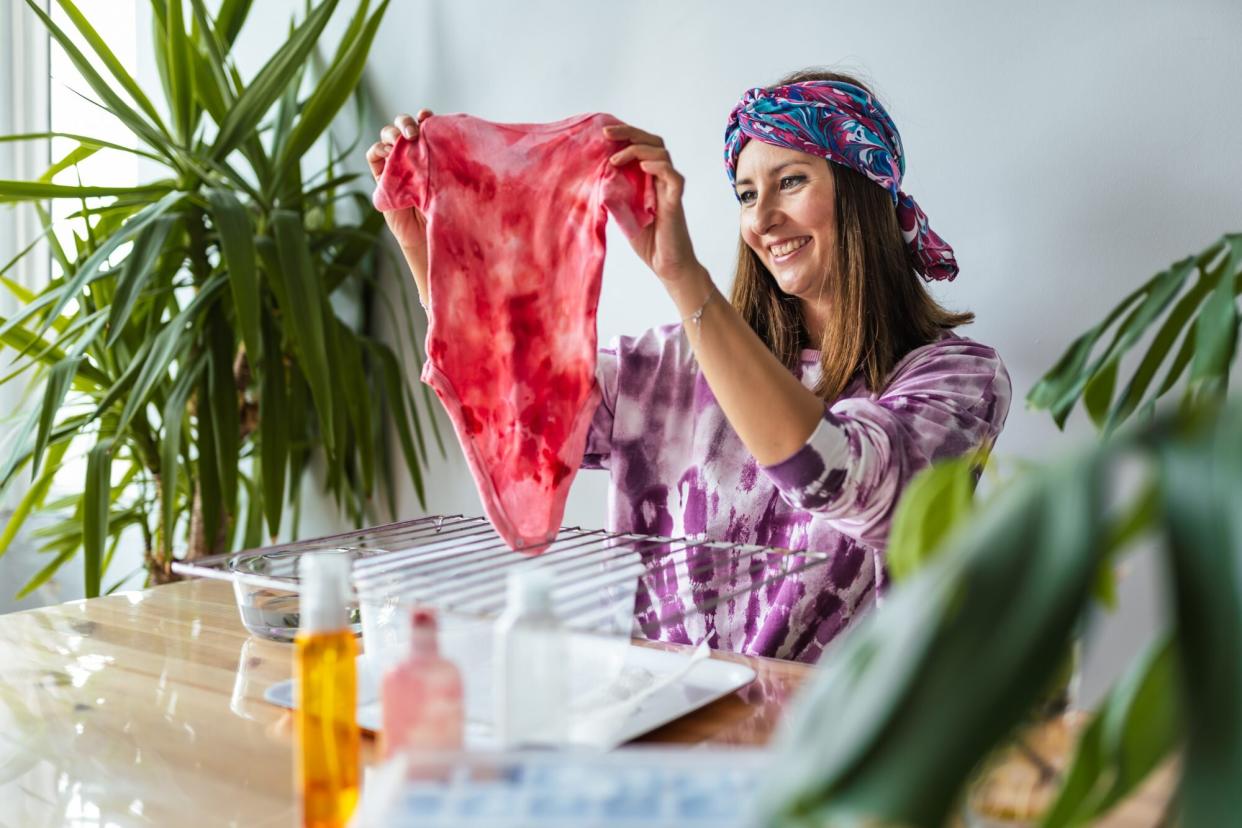Three Simple, Effective Ways to Remove Tie-Dye from Your Skin

Kemal Yildirim / Getty Images
If you're an avid tie-dyer, then you likely already know the importance of wearing protective gear—tie-dye stains can be tough to remove, but accidents happen even to seasoned pros. If you managed to get the colorful dye on your skin, don't fret: There are a number of methods you can employ to get tie-dye off of your hands, and knowing how to clean up these accidents will make the process far more enjoyable.
"The main thing is you've got two different ideas," says Allie Kukuch, head chemist at Rit Dye. "You're changing the pH, or you're changing the charge." Kukuch explains that when you're dyeing fabrics like cotton, oftentimes adding salt will help the dye bond with the material. "The reason that we add salt to the dye bath—[it's] because we want the cotton to be a positive charge, so that the negatively charged dye will associate with the cotton stronger," she explains. "A lot of your removal techniques are going to be the opposite of that. You're trying to make them repel from each other, from your hands, and the dye." Ahead, our experts share some of their best techniques for breaking the chemical bond to get tie-dye off of your hands.
Exfoliate
According to Kukuch, the layer of skin on the surface of our hands is actually dead, and dye is just sitting on it. By exfoliating, you strip away this dead layer and the dye that has stained it. Whatever you do, don't over-scrub and slough off an entire layer of skin. Instead, exfoliate gently but effectively—baking soda, which you probably have at home, is a good option. Sugar or body scrubs are also effective, according to Jonathon Spagat, creative director at Rit Dye. Lotion and/or oils in scrubs are helpful in re-moisturizing your skin after you've stripped away the dead layer.
Make sure that you don't dilute your baking soda or sugar with too much water or lotion. An excess of liquid will eliminate the abrasiveness needed to remove the dye. Err on the side of grainy, adding just enough liquid to spread it over your hands.
Use Oil- and Citrus-Based Removers
"You can use orange and lemon to wash your hands," says Rebecca Saylor, tie-dye artist and owner of OodleBaDoodle, an online shop that sells tie-dye kits and home décor. One of her favorite solutions is the Orange Goop Waterless Hand Cleaner ($14.97, amazon.com). "You put it on dry hands, let it sit, and it'll turn into an oil, almost," she adds. "You wipe that off and wash your hands." Rebecca Burton of Tulip Color, also recommends citrus soap. She cites Fast Orange Soap ($15.65, amazon.com)—frequently used by mechanics—as an effective solution. Kukuck notes, "Any sort of citrus cleaner is going to be all-natural, biodegradable. It's going to be fine for the environment and your hands. That would probably be the thing I would look for if I were looking for something gentle and friendly."
As for the oil component, Kukuck emphasizes that the type of dye you choose matters. "If you're working with a dispersed dye, dispersed dyes don't like water very much," she says. "What they do like is oil. They're going to be more attracted to the oil part than your skin, which is mostly water." That being said, you may not need to seek out a specific product—it could be something you already have. "We have had a lot of feedback from customers that have used mineral oils...and even hair conditioner," says Burton.
Wash Your Hands as Soon as Possible
"Rinsing your hands right away before [the dye] sets in is key," says Saylor. "The dye needs time. If you can get it off your skin quickly, you're going to have less staining." She recommends the Masters Artist Soap ($9.16, amazon.com) as one of the most effective removers she has found. If you don't want to buy a special soap, look in your kitchen. "Dawn Dish Soap ($13.58, amazon.com) is a great stain remover," says Burton, "And it just so happens to be great for helping with the removal of dye."
Curt Nixon, VP of sales at SEI Crafts, a manufacturer of water-based dyes, also notes that timeliness is essential. "You want to wipe your hands off as soon as possible," he says. "You wouldn't want to wait an hour." It's worth noting that the type of dye will also affect how messy things will be. Water-based dyes, according to Nixon, require heat to "lock" the color to the fabric, meaning that the staining of your hands will not be as deep as if you had used a reactive dye. In either case, it's best to wash your hands as soon as possible.

